Computer Alloy Design of Ti Modified Al-Si-Mg-Sr Casting Alloys for Achieving Simultaneous Enhancement in Strength and Ductility
Abstract
1. Introduction
2. Computational Methods
2.1. Thermodynamic Modeling
2.2. Scheil-Gulliver Solidification Simulations
2.3. Machine Learning Technique
3. Experimental Procedure
4. Results & Discussion
4.1. Thermodynamic Database of Quinary Al-Si-Mg-Sr-Ti System and Its Validation
4.1.1. Quaternary Al-Si-Mg-Ti System
4.1.2. Quinary Al-Si-Mg-Sr-Ti System and Key Experimental Validation
4.2. Efficient Design of Optimal Ti in A356-0.005Sr Alloys and Experimental Validation
4.2.1. Alloy Design
4.2.2. Experimental Validation
5. Conclusions
- All boundaries binary/ternary systems were first unified, and the thermodynamic databases of Al-Si-Mg-Ti and Al-Si-Mg-Sr-Ti systems were then directly extrapolated from the boundaries. Their reliability was validated by the experimental data from the literature and the present work.
- Combining CT, key experiments, and ML within the Bayesian optimization framework, the quantitative relationship “composition/processing-microstructure-properties” of A356-0.005Sr with different Ti contents was constructed. Based on the evaluated acquisition function EI values, the A356-0.005Sr alloy with an additional 0.08 wt.% Ti was designed to own the best performance point (UTS = 199.6 MPa, YS = 101.6 MPa, and EL = 12.3%) and was finally experimentally validated.
- The successful design of Ti-modified A356-Sr alloys indicated that combining ML, CT, and key experiments within the Bayesian optimization framework is one of the most efficient alloy design methods when there is a small experimental dataset. Meanwhile, with the acquisition function EI, the optimal alloy composition with the best comprehensive properties can be directly recommended, resulting in the avoidance of blindly conducting expensive experiments and human involvement in the next iteration. This can greatly reduce the difficulty of sampling in the complex composition space. Therefore, the presently proposed integration method is anticipated to serve as a general one for alloy design, especially the design of alloys with high-dimensional composition space.
Supplementary Materials
Author Contributions
Funding
Institutional Review Board Statement
Informed Consent Statement
Data Availability Statement
Conflicts of Interest
References
- Kaufman, J.G.; Rooy, E.L. Aluminum Alloy Castings: Properties, Processes, and Applications; ASM International: Almere, The Netherlands, 2004; ISBN 0-87170-803-5. [Google Scholar]
- Yi, W.; Liu, G.; Gao, J.; Zhang, L. Boosting for Concept Design of Casting Aluminum Alloys Driven by Combining Computational Thermodynamics and Machine Learning Techniques. J. Mater. Info. 2021, 1, 11. [Google Scholar] [CrossRef]
- Eiken, J.; Apel, M. Eutectic Morphology Evolution and Sr-Modification in Al-Si Based Alloys Studied by 3D Phase-Field Simulation Coupled to Calphad Data. IOP Conf. Ser. Mater. Sci. Eng. 2015, 84, 012084. [Google Scholar] [CrossRef]
- Liu, X.; Zhang, Y.; Beausir, B.; Liu, F.; Esling, C.; Yu, F.; Zhao, X.; Zuo, L. Twin-Controlled Growth of Eutectic Si in Unmodified and Sr-Modified Al–12.7%Si Alloys Investigated by SEM/EBSD. Acta Mater. 2015, 97, 338–347. [Google Scholar] [CrossRef]
- Yi, W.; Liu, G.; Lu, Z.; Gao, J.; Zhang, L. Efficient Alloy Design of Sr-Modified A356 Alloys Driven by Computational Thermodynamics and Machine Learning. J. Mater. Sci. Technol. 2022, 112, 277–290. [Google Scholar] [CrossRef]
- Xu, C.; Wang, C.Y.; Yang, H.J.; Liu, Z.G.; Yamagata, H.; Ma, C.L. Solidification Behavior and Mechanical Properties of Al-Si-Mg Alloy with Ti Addition. In Materials Science Forum; Trans Tech Publications Ltd.: Schwyz, Switerland, 2016; Volume 850, pp. 594–602. [Google Scholar]
- Yang, C.; Liu, Z.; Zheng, Q.; Cao, Y.; Dai, X.; Sun, L.; Zhao, J.; Xing, J.; Han, Q. Ultrasound Assisted In-Situ Casting Technique for Synthesizing Small-Sized Blocky Al3Ti Particles Reinforced A356 Matrix Composites with Improved Mechanical Properties. J. Alloys Compd. 2018, 747, 580–590. [Google Scholar] [CrossRef]
- Schumacher, P.; Greer, A.L. Enhanced Heterogeneous Nucleation of α-Al in Amorphous Aluminium Alloys. Mater. Sci. Eng. A 1994, 181, 1335–1339. [Google Scholar] [CrossRef]
- Schumacher, P.; Greer, A.L. Heterogeneously Nucleated α-Al in Amorphous Aluminium Alloys. Mater. Sci. Eng. A 1994, 178, 309–313. [Google Scholar] [CrossRef]
- Schumacher, P.; Greer, A.L. Studies of the Action of Grain-Refining Particles in Aluminium Alloys. In Essential Readings in Light Metals; Springer: Berlin/Heidelberg, Germany, 2016; pp. 366–374. [Google Scholar]
- Lee, Y.C.; Dahle, A.K.; StJohn, D.H.; Hutt, J.E.C. The Effect of Grain Refinement and Silicon Content on Grain Formation in Hypoeutectic Al–Si Alloys. Mater. Sci. Eng. A 1999, 259, 43–52. [Google Scholar] [CrossRef]
- Easton, M.; StJohn, D. An Analysis of the Relationship between Grain Size, Solute Content, and the Potency and Number Density of Nucleant Particles. Metall. Mater. Trans. A 2005, 36, 1911–1920. [Google Scholar] [CrossRef]
- Easton, M.; Davidson, C.; St John, D. Effect of Alloy Composition on the Dendrite Arm Spacing of Multicomponent Aluminum Alloys. Metall. Mater. Trans. A 2010, 41, 1528–1538. [Google Scholar] [CrossRef]
- Easton, M.A.; StJohn, D.H. The Effect of Alloy Content on the Grain Refinement of Aluminium Alloys. In Essential Readings in Light Metals; Springer: Berlin/Heidelberg, Germany, 2016; pp. 393–399. [Google Scholar]
- Lipiński, T. Effect of Sr, Ti and B Additions as Powder and a Preliminary Alloy with Al on Microstructure and Tensile Strength AlSi9Mg Alloy. Manuf. Technol. 2019, 19, 807–812. [Google Scholar] [CrossRef]
- Lipiński, T. Modification of the Al-9% SiMg Alloy with Aluminium, Boron and Titanium Fast Cooled Mixtures. Acta Phisica Pol. A 2016, 130, 982–984. [Google Scholar] [CrossRef]
- Lipiński, T. Double Modification of AlSi9Mg Alloy With Boron, Titanium And Strontium. Arch. Metall. Mater. 2015, 60, 2415–2419. [Google Scholar] [CrossRef]
- Samuel, A.M.; Doty, H.W.; Valtierra, S.; Samuel, F.H. Effect of Grain Refining and Sr-Modification Interactions on the Impact Toughness of Al–Si–Mg Cast Alloys. Mater. Des. 2014, 56, 264–273. [Google Scholar] [CrossRef]
- Chen, X.G.; Fortier, M. TiAlSi Intermetallic Formation and Its Impact on the Casting Processing in Al–Si Alloys. J. Mater. Process. Technol. 2010, 210, 1780–1786. [Google Scholar] [CrossRef]
- Li, Y.; Gu, Q.-F.; Luo, Q.; Pang, Y.; Chen, S.-L.; Chou, K.-C.; Wang, X.-L.; Li, Q. Thermodynamic Investigation on Phase Formation in the Al–Si Rich Region of Al–Si–Ti System. Mater. Des. 2016, 102, 78–90. [Google Scholar] [CrossRef]
- Lu, Z.; Zhang, L. Thermodynamic Description of the Quaternary Al-Si-Mg-Sc System and Its Application to the Design of Novel Sc-Additional A356 Alloys. Mater. Des. 2017, 116, 427–437. [Google Scholar] [CrossRef]
- Lu, Z.; Zhang, L.; Wang, J.; Yao, Q.; Rao, G.; Zhou, H. Understanding of Strengthening and Toughening Mechanisms for Sc-Modified Al-Si-(Mg) Series Casting Alloys Designed by Computational Thermodynamics. J. Alloys Compd. 2019, 805, 415–425. [Google Scholar] [CrossRef]
- Zhu, L.; Soto-Medina, S.; Cuadrado-Castillo, W.; Hennig, R.G.; Manuel, M.V. New Experimental Studies on the Phase Diagram of the Al-Cu-Fe Quasicrystal-Forming System. Mater. Des. 2020, 185, 108186. [Google Scholar] [CrossRef]
- Ta, N.; Zhang, L.; Du, Y. Design of the Precipitation Process for Ni-Al Alloys with Optimal Mechanical Properties: A Phase-Field Study. Metall. Mater. Trans. A 2014, 45, 1787–1802. [Google Scholar] [CrossRef]
- Gao, J.; Malchère, A.; Yang, S.; Campos, A.; Luo, T.; Quertite, K.; Steyer, P.; Girardeaux, C.; Zhang, L.; Mangelinck, D. Dewetting of Ni Silicide Thin Film on Si Substrate: In-Situ Experimental Study and Phase-Field Modeling. Acta Mater. 2022, 223, 117491. [Google Scholar] [CrossRef]
- Zhong, J.; Chen, L.; Zhang, L. Automation of Diffusion Database Development in Multicomponent Alloys from Large Number of Experimental Composition Profiles. NPJ Comput. Mater. 2021, 7, 1–13. [Google Scholar] [CrossRef]
- Xiao, B.; Luan, J.; Zhao, S.; Zhang, L.; Chen, S.; Zhao, Y.; Xu, L.; Liu, C.T.; Kai, J.J.; Yang, T. Achieving Thermally Stable Nanoparticles in Chemically Complex Alloys via Controllable Sluggish Lattice Diffusion. Nat. Commun. 2022, 13, 4870. [Google Scholar] [CrossRef] [PubMed]
- Wang, J.; Xu, J.; Zhu, Y.; Hu, D.; Lu, N.; Cui, D.; Guo, P. Properties of AgSnO2 Contact Materials Doped with Different Concentrations of Cr. Materials 2022, 15, 4793. [Google Scholar] [CrossRef] [PubMed]
- Hu, W.; Pan, M.; Huang, Z.; Yang, H.; Wu, H.; Pan, L.; Cao, Z.; Zhao, Y. The Stability and Elasticity in Ta-Ti-V Medium-Entropy Alloys Using First-Principles Calculations. Front. Mater. 2021, 8, 651435. [Google Scholar] [CrossRef]
- Altarazi, S.; Allaf, R.; Alhindawi, F. Machine Learning Models for Predicting and Classifying the Tensile Strength of Polymeric Films Fabricated via Different Production Processes. Materials 2019, 12, 1475. [Google Scholar] [CrossRef] [PubMed]
- Wen, C.; Zhang, Y.; Wang, C.; Xue, D.; Bai, Y.; Antonov, S.; Dai, L.; Lookman, T.; Su, Y. Machine Learning Assisted Design of High Entropy Alloys with Desired Property. Acta Mater. 2019, 170, 109–117. [Google Scholar] [CrossRef]
- Chen, Y.; Tian, Y.; Zhou, Y.; Fang, D.; Ding, X.; Sun, J.; Xue, D. Machine Learning Assisted Multi-Objective Optimization for Materials Processing Parameters: A Case Study in Mg Alloy. J. Alloys Compd. 2020, 844, 156159. [Google Scholar] [CrossRef]
- Yu, J.; Xi, S.; Pan, S.; Wang, Y.; Peng, Q.; Shi, R.; Wang, C.; Liu, X. Machine Learning-Guided Design and Development of Metallic Structural Materials. J. Mater. Info. 2021, 1, 9. [Google Scholar] [CrossRef]
- Lookman, T.; Balachandran, P.V.; Xue, D.; Yuan, R. Active Learning in Materials Science with Emphasis on Adaptive Sampling Using Uncertainties for Targeted Design. NPJ Comput. Mater. 2019, 5, 21. [Google Scholar] [CrossRef]
- Reiker, T.; Golumbeanu, M.; Shattock, A.; Burgert, L.; Smith, T.A.; Filippi, S.; Cameron, E.; Penny, M.A. Emulator-Based Bayesian Optimization for Efficient Multi-Objective Calibration of an Individual-Based Model of Malaria. Nat. Commun. 2021, 12, 7212. [Google Scholar] [CrossRef] [PubMed]
- Zuo, Y.; Qin, M.; Chen, C.; Ye, W.; Li, X.; Luo, J.; Ong, S.P. Accelerating Materials Discovery with Bayesian Optimization and Graph Deep Learning. Mater. Today 2021, 51, 126–135. [Google Scholar] [CrossRef]
- Tang, Y.; Du, Y.; Zhang, L.; Yuan, X.; Kaptay, G. Thermodynamic Description of the Al–Mg–Si System Using a New Formulation for the Temperature Dependence of the Excess Gibbs Energy. Thermochim. Acta 2012, 527, 131–142. [Google Scholar] [CrossRef]
- Zhang, L.; Wang, J.; Yong, D.; Hu, R.; Nash, P.; Lu, X.G.; Chao, J. Thermodynamic Properties of the Al–Fe–Ni System Acquired via a Hybrid Approach Combining Calorimetry, First-Principles and CALPHAD. Acta Mater. 2009, 57, 5324–5341. [Google Scholar] [CrossRef]
- Hao, D.; Hu, B.; Zhang, K.; Zhang, L.; Du, Y. The Quaternary Al–Fe–Ni–Si Phase Equilibria in Al-Rich Corner: Experimental Measurement and Thermodynamic Modeling. J. Mater. Sci. 2014, 49, 1157–1169. [Google Scholar] [CrossRef]
- Dinsdale, A.T. SGTE Data for Pure Elements. Calphad 1991, 15, 317–425. [Google Scholar] [CrossRef]
- Redlich, O.; Kister, A.T. Algebraic Representation of Thermodynamic Properties and the Classification of Solutions. Ind. Eng. Chem. 1948, 40, 345–348. [Google Scholar] [CrossRef]
- Hillert, M. Empirical Methods of Predicting and Representing Thermodynamic Properties of Ternary Solution Phases. Calphad 1980, 4, 1–12. [Google Scholar] [CrossRef]
- Hillert, M. The Compound Energy Formalism. J. Alloys Compd. 2001, 320, 161–176. [Google Scholar] [CrossRef]
- Gulliver, G.H. The Quantitative Effect of Rapid Cooling upon the Constitution of Binary Alloys. J. Inst. Met. 1915, 13, 263–291. [Google Scholar]
- Jeong, J.; Im, J.; Song, K.; Kwon, M.; Sang, H.O. Transmission Electron Microscopy and Thermodynamic Studies of CaO-Added AZ31 Mg Alloys. Acta Mater. 2013, 61, 3267–3277. [Google Scholar] [CrossRef]
- Cheng, T.; Tang, Y.; Zhang, L. Update of Thermodynamic Descriptions of the Binary Al-Sn and Ternary Mg-Al-Sn Systems. Calphad 2019, 64, 354–363. [Google Scholar] [CrossRef]
- Gao, J.; Zhong, J.; Liu, G.; Yang, S.; Song, B.; Zhang, L.; Liu, Z. A Machine Learning Accelerated Distributed Task Management System (Malac-Distmas) and Its Application in High-Throughput CALPHAD Computations Aiming at Efficient Alloy Design. Adv. Powder Mater. 2021, 1, 100005. [Google Scholar] [CrossRef]
- Schmid-Fetzer, R.; Chang, Y.A.; Chen, S.L.; Oates, W.A.; Cao, W.; Yang, Y.; Zhang, F.; Wu, K. PANDAT Software with PanEngine, PanOptimizer and PanPrecipitation for Multi-Component Phase Diagram Calculation and Materials Property Simulation. Calphad 2009, 33, 328–342. [Google Scholar]
- Xue, D.; Balachandran, P.V.; Hogden, J.; Theiler, J.; Xue, D.; Lookman, T. Accelerated Search for Materials with Targeted Properties by Adaptive Design. Nat. Commun. 2016, 7, 11241. [Google Scholar] [CrossRef]
- Frazier, P.I.; Wang, J. Bayesian Optimization for Materials Design. In Information Science for Materials Discovery and Design; Springer: Cham, Switzerland, 2016; pp. 45–75. ISBN 978-3-319-23870-8. [Google Scholar]
- Paszke, A.; Gross, S.; Massa, F.; Lerer, A.; Bradbury, J.; Chanan, G.; Killeen, T.; Lin, Z.; Gimelshein, N.; Antiga, L. Pytorch: An Imperative Style, High-Performance Deep Learning Library; Curran and Associates, Inc.: San Francisco, CA, USA, 2019; Volume 32, pp. 8024–8035. [Google Scholar]
- Akiba, T.; Sano, S.; Yanase, T.; Ohta, T.; Koyama, M. Optuna: A Next-Generation Hyperparameter Optimization Framework; Association for Computing Machinery: New York, NU, USA, 2019; pp. 2623–2631. [Google Scholar]
- Azimi, H.; Nourouzi, S.; Jamaati, R. Effects of Ti Particles and T6 Heat Treatment on the Microstructure and Mechanical Properties of A356 Alloy Fabricated by Compocasting. Mater. Sci. Eng. A 2021, 818, 141443. [Google Scholar] [CrossRef]
- Sun, J.; Zeng, G.; Zou, J.; Wang, Y.; Rao, D.; Pan, L.; Hu, Z. Microstructure and High Temperature Mechanical Properties of Al3Ti/A356 Aluminum Matrix Composite by in Situ Reaction. Acta Mater. Compos. Sin. 2021, 38, 2989–2996. (In Chinese) [Google Scholar] [CrossRef]
- Zhang, L.; Du, Y.; Xu, H.; Liu, S.; Liu, Y.; Zheng, F.; Dupin, N.; Zhou, H.; Tang, C. Phase Equilibria and Thermal Analysis in the Fe–Mn–Ni System. Int. J. Mater. Res. 2009, 100, 160–175. [Google Scholar] [CrossRef]
- Drouzy, M.; Jacob, S.; Richard, M. Interpretation of Tensile Results by Means of Quality Index and Probable Yield Strength-Application to Al-Si7 Mg Foundry Alloys-France. Int. Cast Met. J. 1980, 5, 43–50. [Google Scholar]
- Dezellus, O.; Gardiola, B.; Andrieux, J.; Lomello-Tafin, M.; Viala, J.C. On the Liquid/Solid Phase Equilibria in the Al-Rich Corner of the Al-Si-Ti Ternary System. J. Phase Equilib. Diffus. 2014, 35, 137–145. [Google Scholar] [CrossRef]
- Peronnet, M.; Barbeau, F.; Bosselet, F.; Viala, J.; Bouix, J. Comportement Chimique Du Titane Dans Un Alliage Liquide Aluminium-Silicium. J. Phys. IV France 1999, 9, 223–228. [Google Scholar] [CrossRef]
- Zhong, Y.; Wolverton, C.; Chang, Y.A.; Liu, Z.-K. A Combined CALPHAD/First-Principles Remodeling of the Thermodynamics of Al–Sr: Unsuspected Ground State Energies by “Rounding up the (Un) Usual Suspects”. Acta Mater. 2004, 52, 2739–2754. [Google Scholar] [CrossRef]
- Kattner, U.R.; Lin, J.-C.; Chang, Y.A. Thermodynamic Assessment and Calculation of the Ti-Al System. Metall. Trans. A 1992, 23, 2081–2090. [Google Scholar] [CrossRef]
- Zhong, Y.; Sofo, J.O.; Luo, A.A.; Liu, Z.-K. Thermodynamics Modeling of the Mg–Sr and Ca–Mg–Sr Systems. J. Alloys Compd. 2006, 421, 172–178. [Google Scholar] [CrossRef]
- Yi, W.; Gao, J.; Tang, Y.; Zhang, L. Thermodynamic Descriptions of Ternary Al–Si–Sr System Supported by Key Experiments. Calphad 2020, 68, 101732. [Google Scholar] [CrossRef]
- Peng, Y.; Zhao, D.; Hu, B.; Zhou, L.; Du, Y.; Gang, T.; Liu, S.; Chang, K. Thermodynamic Modeling of the Sr-M (M = Fe, Mn, Ni, Ti, V) Systems. J. Phase Equilib. Diffus. 2010, 32, 42–47. [Google Scholar] [CrossRef]
- Murray, J.L. The Mg-Ti (Magnesium-Titanium) System. Bull. Alloy. Phase Diagr. 1986, 7, 245–248. [Google Scholar] [CrossRef]
- Edalati, K.; Emami, H.; Staykov, A.; Smith, D.J.; Akiba, E.; Horita, Z. Formation of Metastable Phases in Magnesium–Titanium System by High-Pressure Torsion and Their Hydrogen Storage Performance. Acta Mater. 2015, 99, 150–156. [Google Scholar] [CrossRef]
- Janz, A.; Gröbner, J.; Mirković, D.; Medraj, M.; Zhu, J.; Chang, Y.A.; Schmid-Fetzer, R. Experimental Study and Thermodynamic Calculation of Al–Mg–Sr Phase Equilibria. Intermetallics 2007, 15, 506–519. [Google Scholar] [CrossRef]
- Kerimov, K.M.; Dunaev, S.F.; Sljusarenko, E.M. Investigation of the Structure of Ternary Phases in Al-Mg-Ti, Al-Mg-V and Al-Mg-Cr Systems.Pdf. J. Less Common Met. 1987, 133, 297–302. [Google Scholar] [CrossRef]
- Wei, Y.; Aiping, W.; Guisheng, Z.; Jialie, R. 5A06/TA2 Diffusion Bonding with Nb Diffusion-Retarding Layers. Mater. Lett. 2008, 62, 2836–2839. [Google Scholar] [CrossRef]
- Zhang, F.Y.; Yan, M.F.; You, Y.; Zhang, C.S.; Chen, H.T. Prediction of Elastic and Electronic Properties of Cubic Al18Ti2Mg3 Phase Coexisting with Al3Ti in Al–Ti–Mg System. Physica B Condens. Matter 2013, 408, 68–72. [Google Scholar] [CrossRef]
- Wang, J.; Liu, T.; Liu, Y.; Wu, C.; Su, X. Study on Evolution of Ti-Containing Intermetallic Compounds in Alloy 2618-Ti during Homogenization. High Temp. Mater. Process. 2015, 34, 621–625. [Google Scholar] [CrossRef]
- Sundman, B.; Ågren, J. A Regular Solution Model for Phases with Several Components and Sublattices, Suitable for Computer Applications. J. Phys. Chem. Solids 1981, 42, 297–301. [Google Scholar] [CrossRef]
- Zhang, J.; Gao, J.; Song, B.; Zhang, L.; Han, C.; Cai, C.; Zhou, K.; Shi, Y. A Novel Crack-Free Ti-Modified Al-Cu-Mg Alloy Designed for Selective Laser Melting. Addit. Manuf. 2021, 38, 101829. [Google Scholar] [CrossRef]

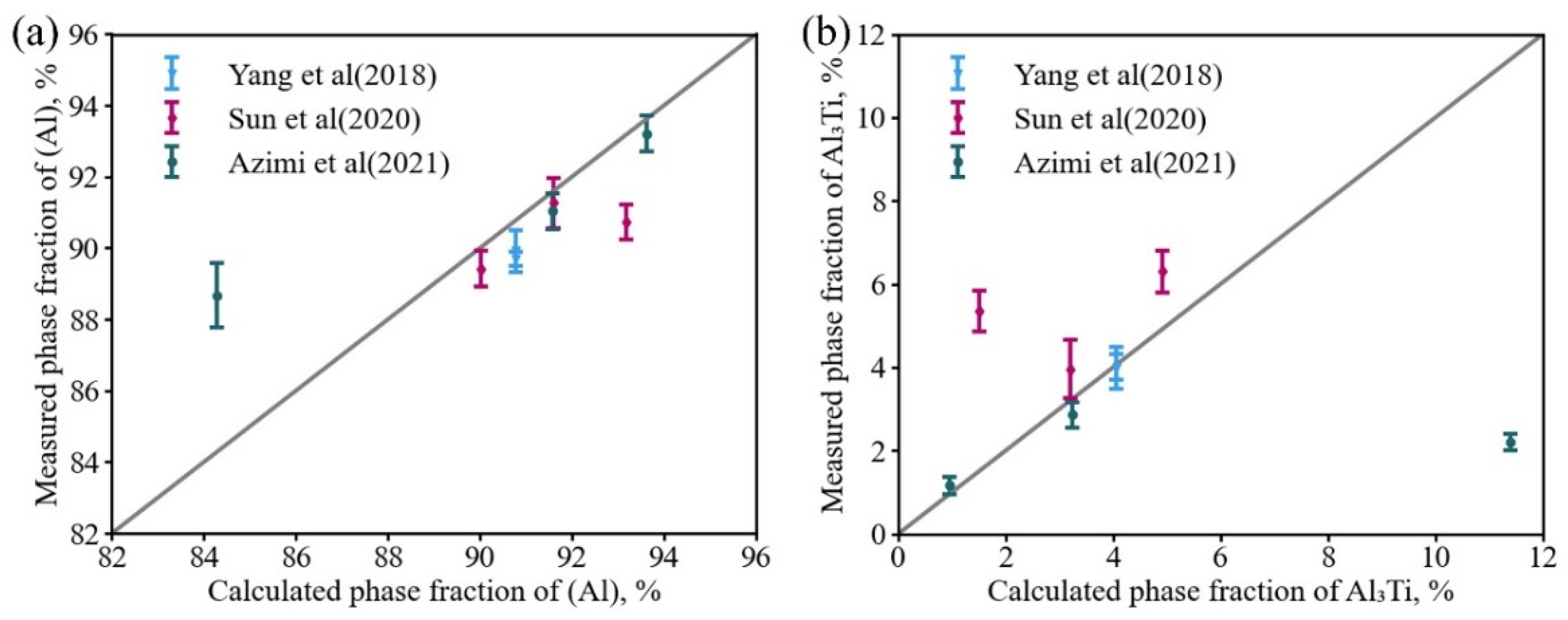

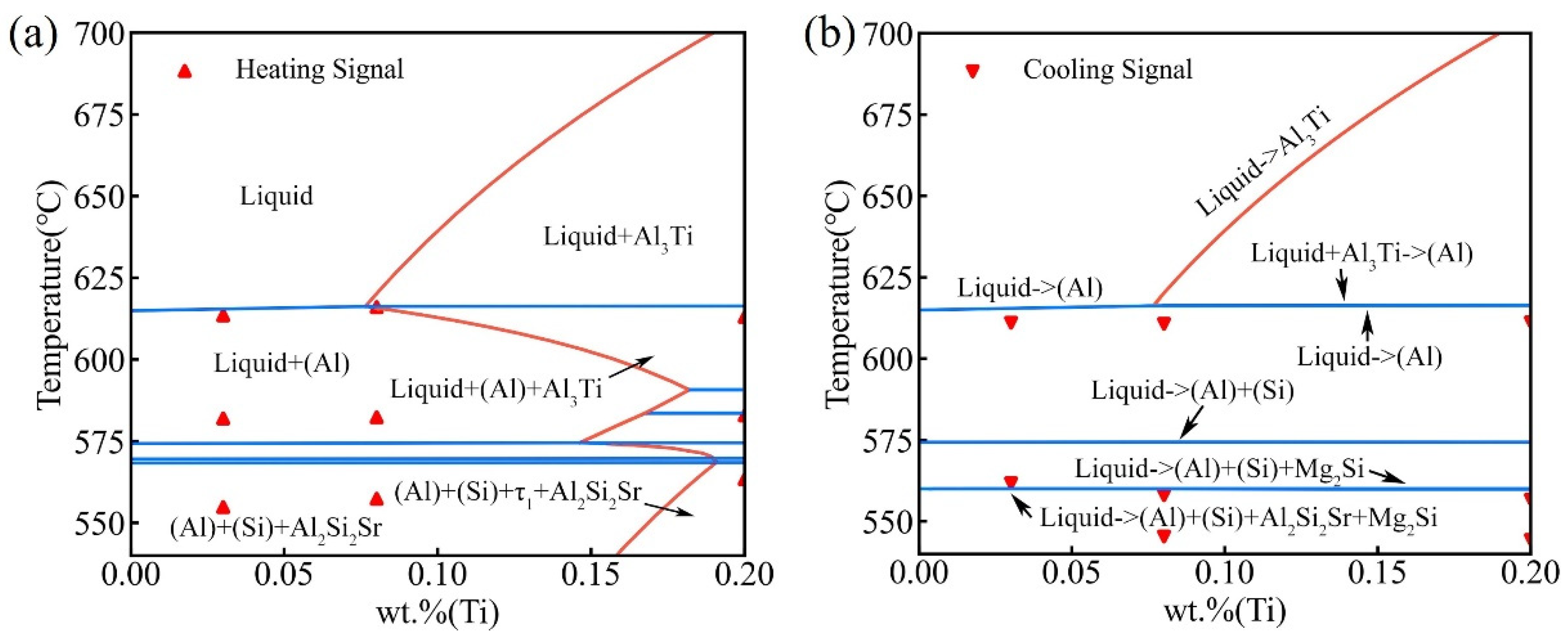

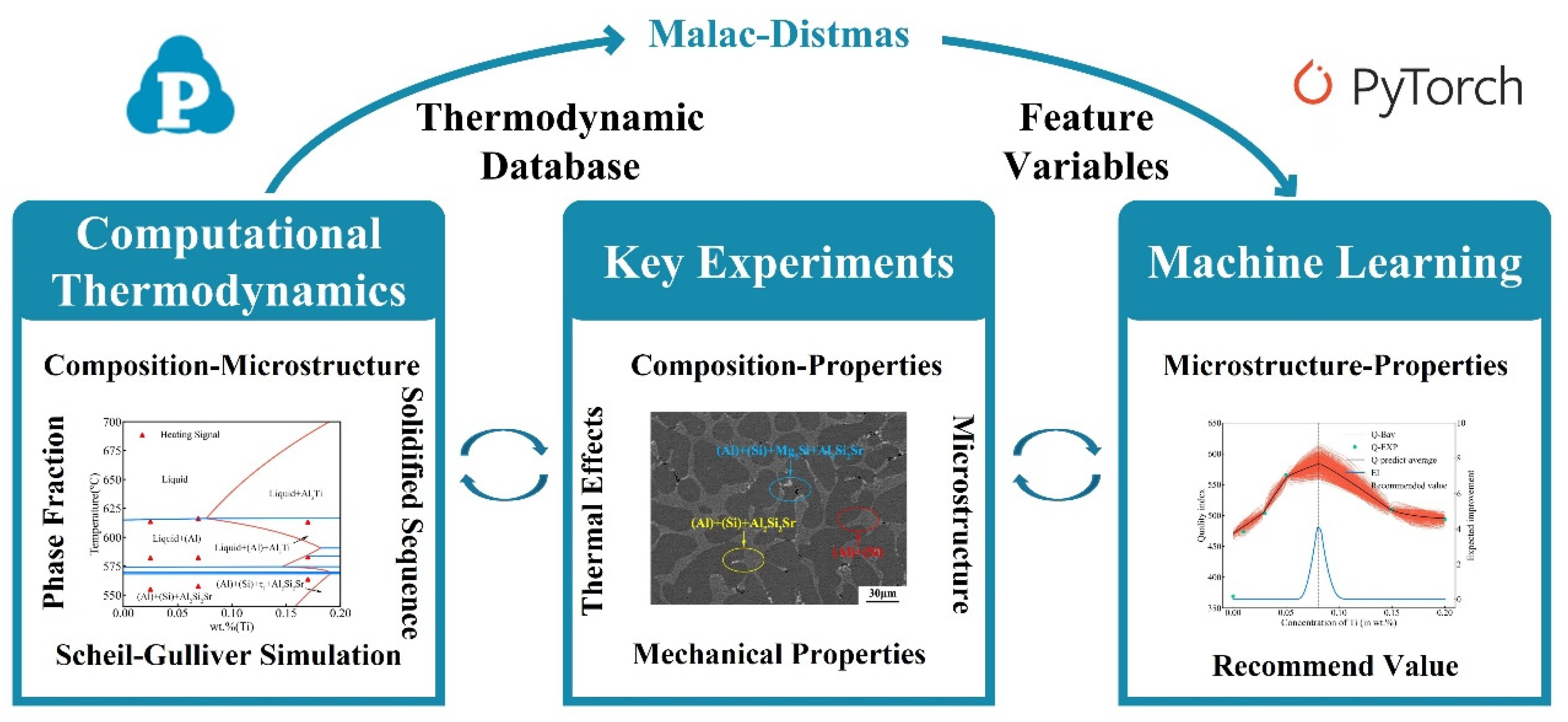
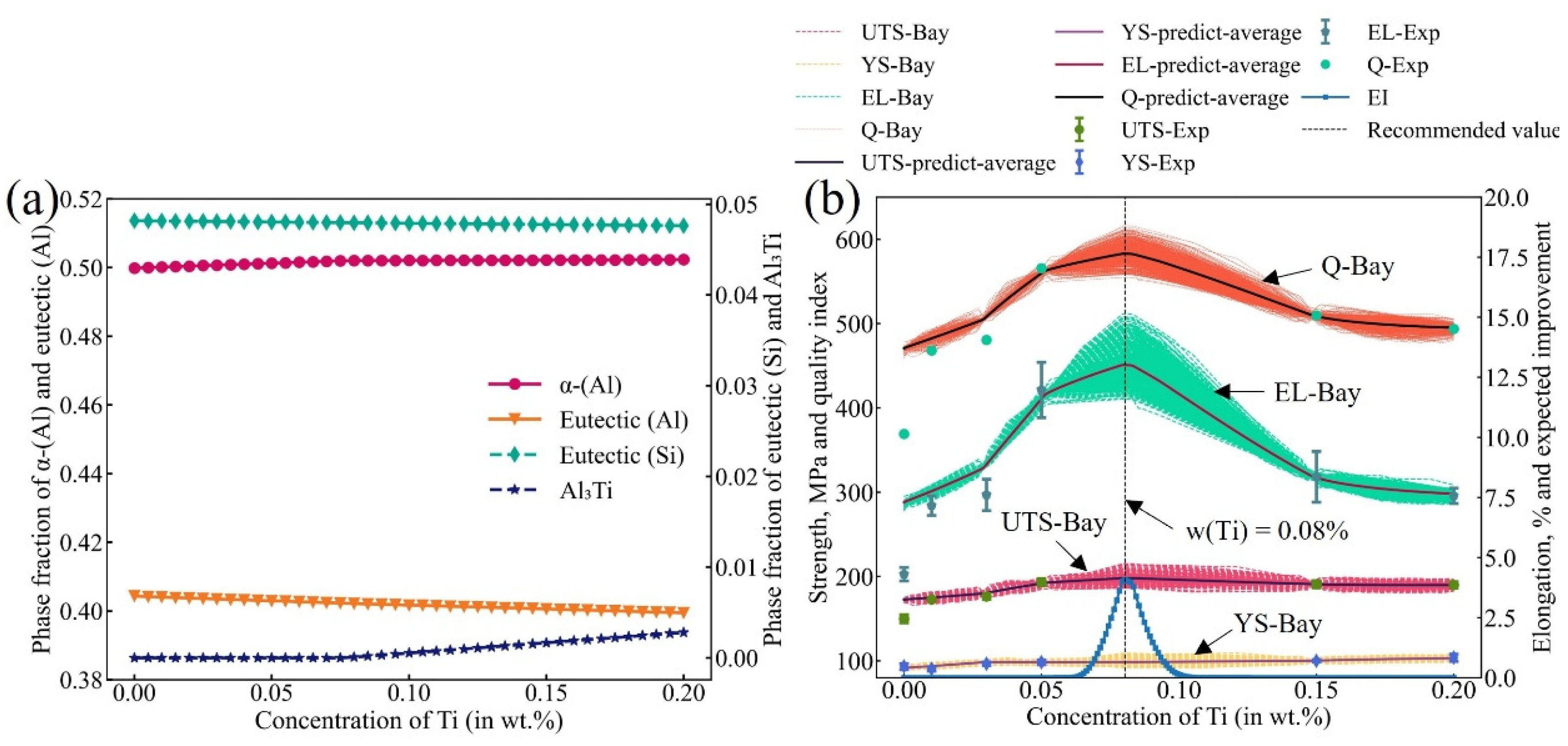
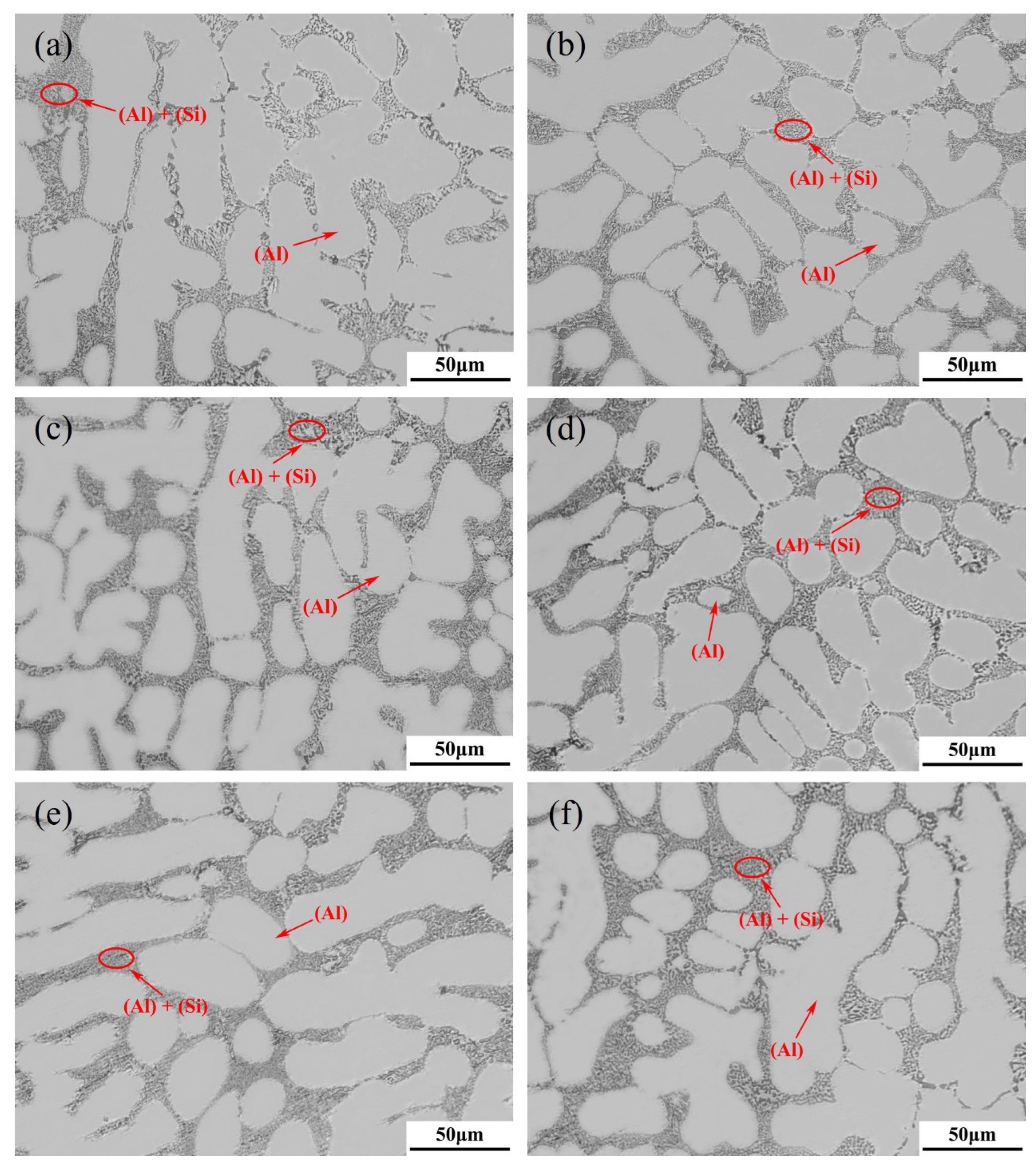
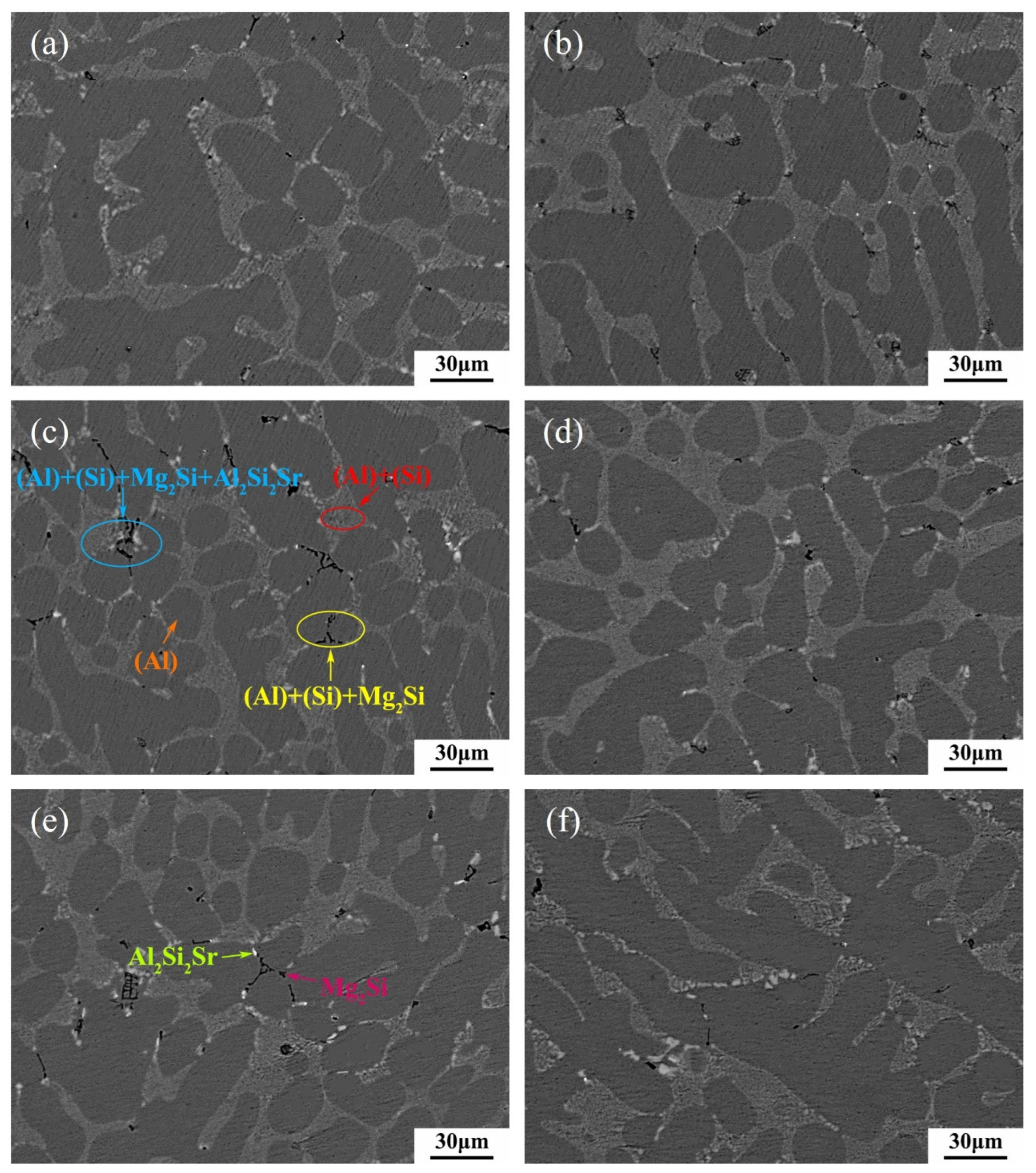
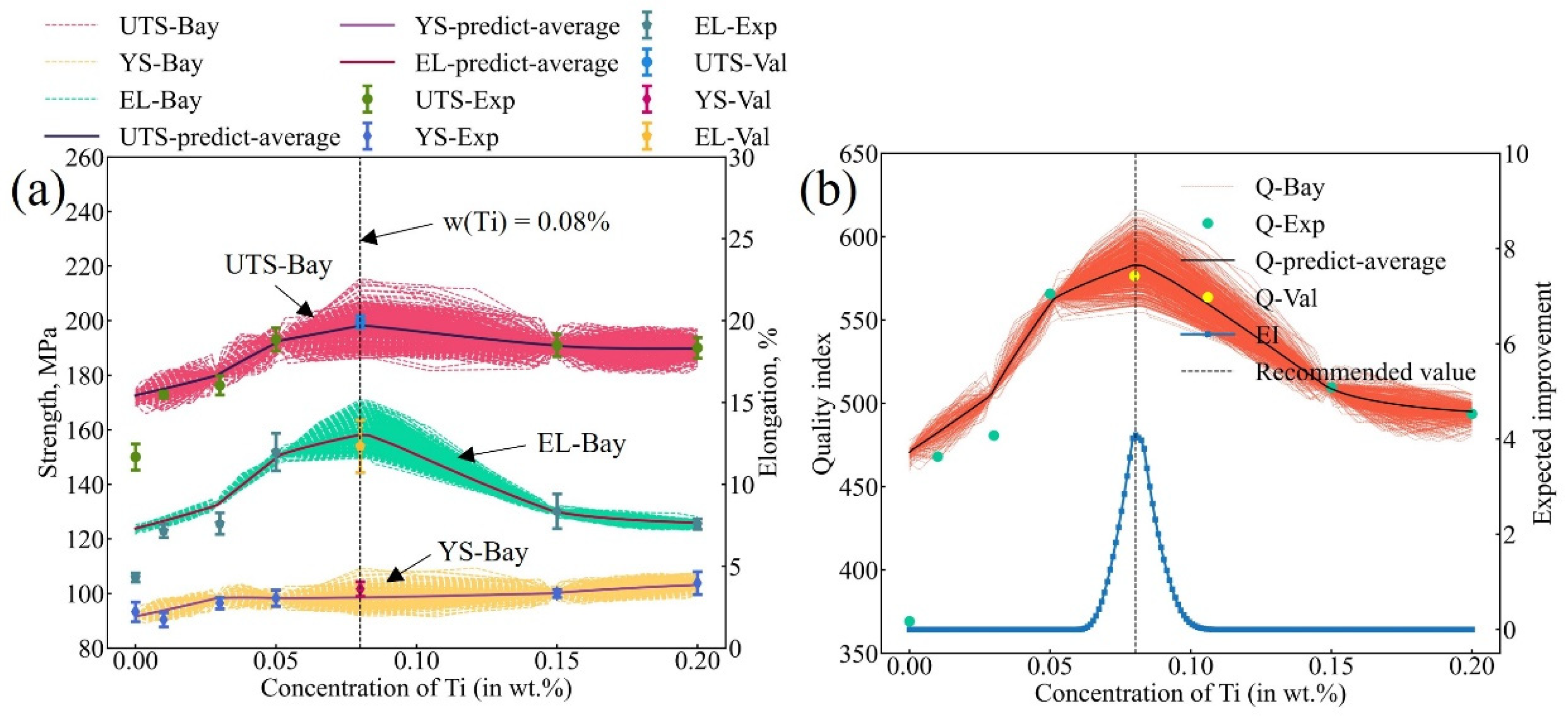
| No. * | Nominal Compositions (wt.%) | Actual Compositions Measured by ICP and CA (wt.%) ** | ||||
|---|---|---|---|---|---|---|
| Al | Si | Mg | Sr | Ti | ||
| D1 | Al-7.0Si-0.45Mg-0.005Sr-0.03Ti | Bal. | 6.63 | 0.42 | 0.0036 | 0.025 |
| D2 | Al-7.0Si-0.45Mg-0.005Sr-0.08Ti | Bal. | 6.96 | 0.41 | 0.0043 | 0.069 |
| D3 | Al-7.0Si-0.45Mg-0.005Sr-0.20Ti | Bal. | 7.08 | 0.39 | 0.0031 | 0.170 |
| M1 | Al-7.0Si-0.45Mg-0.005Sr | Bal. | 6.52 | 0.38 | 0.0041 | / |
| M2 | Al-7.0Si-0.45Mg-0.005Sr-0.01Ti | Bal. | 7.08 | 0.33 | 0.0041 | 0.010 |
| M3 | Al-7.0Si-0.45Mg-0.005Sr-0.03Ti | Bal. | 6.63 | 0.36 | 0.0032 | 0.024 |
| M4 | Al-7.0Si-0.45Mg-0.005Sr-0.05Ti | Bal. | 6.86 | 0.35 | 0.0033 | 0.037 |
| M5 | Al-7.0Si-0.45Mg-0.005Sr-0.15Ti | Bal. | 7.21 | 0.37 | 0.0027 | 0.11 |
| M6 | Al-7.0Si-0.45Mg-0.005Sr-0.20Ti | Bal. | 7.08 | 0.37 | 0.0028 | 0.15 |
| O1 | Al-7.0Si-0.45Mg-0.005Sr-0.08Ti | Bal. | 6.96 | 0.36 | 0.0037 | 0.057 |
Disclaimer/Publisher’s Note: The statements, opinions and data contained in all publications are solely those of the individual author(s) and contributor(s) and not of MDPI and/or the editor(s). MDPI and/or the editor(s) disclaim responsibility for any injury to people or property resulting from any ideas, methods, instructions or products referred to in the content. |
© 2022 by the authors. Licensee MDPI, Basel, Switzerland. This article is an open access article distributed under the terms and conditions of the Creative Commons Attribution (CC BY) license (https://creativecommons.org/licenses/by/4.0/).
Share and Cite
Zhang, S.; Yi, W.; Zhong, J.; Gao, J.; Lu, Z.; Zhang, L. Computer Alloy Design of Ti Modified Al-Si-Mg-Sr Casting Alloys for Achieving Simultaneous Enhancement in Strength and Ductility. Materials 2023, 16, 306. https://doi.org/10.3390/ma16010306
Zhang S, Yi W, Zhong J, Gao J, Lu Z, Zhang L. Computer Alloy Design of Ti Modified Al-Si-Mg-Sr Casting Alloys for Achieving Simultaneous Enhancement in Strength and Ductility. Materials. 2023; 16(1):306. https://doi.org/10.3390/ma16010306
Chicago/Turabian StyleZhang, Shaoji, Wang Yi, Jing Zhong, Jianbao Gao, Zhao Lu, and Lijun Zhang. 2023. "Computer Alloy Design of Ti Modified Al-Si-Mg-Sr Casting Alloys for Achieving Simultaneous Enhancement in Strength and Ductility" Materials 16, no. 1: 306. https://doi.org/10.3390/ma16010306
APA StyleZhang, S., Yi, W., Zhong, J., Gao, J., Lu, Z., & Zhang, L. (2023). Computer Alloy Design of Ti Modified Al-Si-Mg-Sr Casting Alloys for Achieving Simultaneous Enhancement in Strength and Ductility. Materials, 16(1), 306. https://doi.org/10.3390/ma16010306







